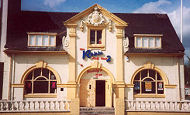Staffordshire

Bilston
Bilston
Bloxwich
Brierley Hill
Burslem
Burton on Trent
Cannock
Darlaston
Handsworth
Hanley
Hartshill
Hednesford
Leek
Lichfield
Longton
Newcastle-under-Lyme
Patshull
Rugeley
Sedgely
Smethwick
Stafford
Stoke-on-Trent
Stone
Tamworth
Tettenhall
Tipton
Tunstall
Tutbury
Uttoxeter
Walsall
Wednesbury
Wednesfield
West Bromwich
Willenhall
Wolverhampton
Wordsley
Staffordshire is a sheltered county in the
west Midlands of England. It is mainly the basin of the River Trent, which
flows south past Stoke-on-Trent, Stone, Burton and eventually towards
Nottingham. North Staffordshire is hilly and bleak, but the area which
adjoins Derbyshire has considerable natural beauty. Cannock Chase is a
peaty, gravelly northern moorland area, a wasteland known for its bracing
climate. The Trent basin itself is rich, fertile land broken by gentle
hills.
Several rivers flow into the Trent, including the Lyme, Tame and Dove and many have been adapted to form canal feeders. Staffordshire's canal system included the Grand Trunk, enabling transport by canal to Liverpool, Birmingham and Worcester.
Rail communications were excellent. The main London and North Western line passed through the county with access to Crewe, Liverpool and many important northern destinations, and the Great Western Line linked Staffordshire with Birmingham, Oxford and London.
At the end of the 19th century, Staffordshire was renowned for its manufacturing industries. The area around Stoke known as the Potteries includes the world-famous Wedgwood works at Etruria, as well as producers of stoneware, porcelain, china, tiles, sanitary ware and chemists' equipment.
Many items in daily use were produced in Staffordshire. These included locks (Wednesfield), keys (Wolverhampton), bolts, hinges and bridle bits (Bloxwich), horse shoes, combs, spurs and stirrups, nuts, rivets, bolts, pulleys and screws, corkscrews, gridirons, frying pans and spoons, spectacles, mouse traps, jews harps and tin toys, blades, files, augers, gimlets and hammers, as well as bicycles from Cannock, anchors, iron chains and pumping machinery from Tipton, gas fittings from West Bromwich, silk from Leek and boat building in the south. Burton was famous for breweries producing pale ale.
Men from Staffordshire also worked in the coal industry: there were just under 400 collieries in 1910. Other extractive industries (gypsum, gravel, sand and stone) were also important employers.
Stafford is the county town. However, while much of Staffordshire was still rural, with remains of older country estates and family seats, other important towns at the end of the nineteenth century included Walsall, Wolverhampton, Lichfield, Leek and Uttoxeter. Its symbol is the Staffordshire Knot, which is displayed in the stonework of many extant drill halls, such as Walsall and Smethwick.

Several rivers flow into the Trent, including the Lyme, Tame and Dove and many have been adapted to form canal feeders. Staffordshire's canal system included the Grand Trunk, enabling transport by canal to Liverpool, Birmingham and Worcester.
Rail communications were excellent. The main London and North Western line passed through the county with access to Crewe, Liverpool and many important northern destinations, and the Great Western Line linked Staffordshire with Birmingham, Oxford and London.
At the end of the 19th century, Staffordshire was renowned for its manufacturing industries. The area around Stoke known as the Potteries includes the world-famous Wedgwood works at Etruria, as well as producers of stoneware, porcelain, china, tiles, sanitary ware and chemists' equipment.
Many items in daily use were produced in Staffordshire. These included locks (Wednesfield), keys (Wolverhampton), bolts, hinges and bridle bits (Bloxwich), horse shoes, combs, spurs and stirrups, nuts, rivets, bolts, pulleys and screws, corkscrews, gridirons, frying pans and spoons, spectacles, mouse traps, jews harps and tin toys, blades, files, augers, gimlets and hammers, as well as bicycles from Cannock, anchors, iron chains and pumping machinery from Tipton, gas fittings from West Bromwich, silk from Leek and boat building in the south. Burton was famous for breweries producing pale ale.
Men from Staffordshire also worked in the coal industry: there were just under 400 collieries in 1910. Other extractive industries (gypsum, gravel, sand and stone) were also important employers.
Stafford is the county town. However, while much of Staffordshire was still rural, with remains of older country estates and family seats, other important towns at the end of the nineteenth century included Walsall, Wolverhampton, Lichfield, Leek and Uttoxeter. Its symbol is the Staffordshire Knot, which is displayed in the stonework of many extant drill halls, such as Walsall and Smethwick.


Bilston
Bloxwich
Brierley Hill
Burslem
Burton on Trent
Cannock
Darlaston
Handsworth
Hanley
Hartshill
Hednesford
Leek
Lichfield
Longton
Newcastle-under-Lyme
Patshull
Rugeley
Sedgely
Smethwick
Stafford
Stoke-on-Trent
Stone
Tamworth
Tettenhall
Tipton
Tunstall
Tutbury
Uttoxeter
Walsall
Wednesbury
Wednesfield
West Bromwich
Willenhall
Wolverhampton
Wordsley
© All material is copyright - refer to the
Terms of Use
the first attempt at content
Introduction
About
Anatomy
Drill
 Database
Database
 Memorabilia
Memorabilia
Resources Glossary
Saving Halls Participate Contact What's New? Terms of Use
Drill
 Database
Database Memorabilia
MemorabiliaResources Glossary
Saving Halls Participate Contact What's New? Terms of Use
The Drill Hall Project - Charting a neglected legacy